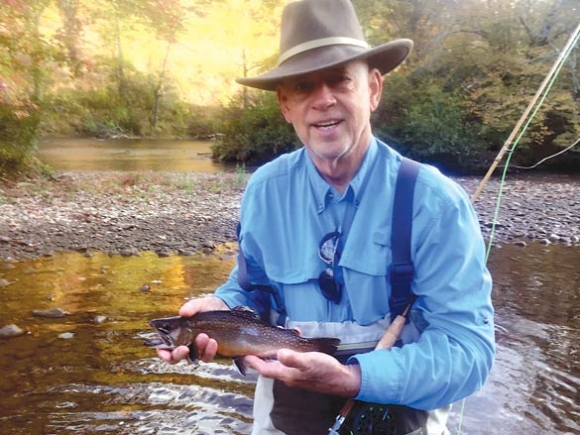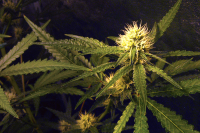Wildlife rides out the drought

From his vantage point on the banks of the Tuckasegee River, it’s not that hard for fly fishing guide Alex Bell to see that there’s something abnormal about the river’s flow this fall.
“I joked with someone the other day it looks like the river’s growing rocks, because I’m seeing rocks I don’t normally see in the river,” Bell said as he grilled some lunchtime bratwurst.
Un-diluting pollution
Across Western North Carolina, waterways are running low, springs are drying up and grasses are turning dry and brown even as weather remains sunny and warm. And biologists are keeping a close eye on what it could all mean for the mountains’ fish and wildlife populations.
“I guess the biggest thing that jumps out at me in all this is if dilution is the solution to pollution, then we’re in trouble in places where pollution has been diluted in the past by normal flows,” said Steve Fraley, aquatic wildlife diversity coordinator for the N.C. Wildlife Resources Commission.
Aquatic species have a hard time when the ratio of pollutants to actual water in a stream is high, and when rainfall ceases pollution levels don’t necessarily adjust their proportions.
Related Items
For instance, larger polluters like factories receive permits that dictate how much wastewater they’re legally able to dump into waterways. Those limits are based on normal flow levels, but if flow is down and pollution level remains steady, at what point does the changing water-pollutant ratio start harming aquatic species? In addition to containing pollutants, wastewater tends to be much warmer than the waterway itself, and most aquatic species in this region require colder water temperatures to thrive.
“Both pollutants and thermal impacts have detrimental effects on aquatic communities,” Fraley said.
For some species, these factors could cause an already-precarious situation to become even more critical.
“We’ve seen a huge reduction in the density of the Appalachian elktoe (mussel) over the last several years believed to be related to some changes in the water quality,” said Fraley, giving an example, “and I could only imagine that those impacts that are related to water quality are going to be exacerbated and made worse during this time of low flow.”
Overall, water quality has increased substantially over the last few decades in WNC. Even the Pigeon River, which used to be so heavily polluted that many species of native fish disappeared from its waters — due mainly to pollution from the paper mill in Canton — is vastly improved. In fact, much of Fraley’s work has focused on reintroducing native species to the cleaned-up waters.
“That’s been going extremely well,” Fraley said. “However, with this low water and relatively high temperatures, we will not be surprised if we see that progress that we’ve made taking a step backwards.”
Resilient creatures
Fraley concentrates his work on non-sport species, like mussels and invertebrates and fish species that anglers aren’t trying to hook. But his colleague Powell Wheeler, fisheries biologist for the Wildlife Commission, spends his days working with sport fish, principally trout, and paints a much less dire picture when discussing the possible impacts of the current drought.
“It’s not the sort of thing a fisheries biologist gets worried about because these fish have been around for millions of years, and dealing with these kinds of hot summers occasionally — I’m not sure there will be a long-term problem,” Wheeler said.
Some fish will likely die as a result of lower water levels and warmer temperatures, especially in lower-elevation streams that are marginal trout habitat even during normal conditions, Wheeler said But those populations will recover and bounce back when rain returns.
The situation is not even as serious as would be possible with water levels as low as they are. While daily highs have been warm, low humidity means temperatures are falling enough at night enough to keep the water sufficiently cool for trout.
“A lot of times anglers are just very worried about years like this, but in the big scheme of things the fish populations are very resilient to these kind of weather patterns,” Wheeler said. “They’re tougher than you think they are.”
That’s true of non-sport fish too, Fraley said — as long as pollution isn’t involved. Trout are a bit luckier in that they tend to live in areas that are more protected from human impact than are many of the species he deals with.
“Most of our important trout resources are in areas that don’t receive a whole lot of detrimental impacts from human activities,” Fraley said. “They’re mostly mountain streams and tailwaters downstream from reservoirs.”
The question, really, is how long the situation might persist. It’s been dry for a while and there’s no significant rain in the forecast — and at this point, it would take months of steady rain to get things back to normal.
“It comes down to a question of significance,” Fraley said. “Some of these headwaters streams that harbor native brook trout are going dry at this point, and that’s going to be something to assess afterward and see what those impacts have been from this drought and will continue to be.”
The prognosis will be critical to gauging the impacts on terrestrial wildlife species, as well. Right now, the drought is not having much of an effect on birds and mammals, according to Joe Yarkovich, wildlife biologist for the Great Smoky Mountains National Park.
“This time of year, the most important food source in the woods is acorns, and the acorns have already dropped,” he said. “It was actually a really good year for that hard mast production.”
While landowners with ponds or streams on their property might be more likely than usual to see wildlife amble by for a drink, animals aren’t dying of thirst — they’re generally able to find water. The grass and other leafy plants that deer and elk like to eat are in short supply, with new growth absent and old growth turning to dried-out straw, but so far there are plenty of twigs and acorns to go around.
“We haven’t seen animals dying of starvation or anything,” said Mike Carraway, district biologist for the Wildlife Commission. “The animals that we’re still seeing are pretty healthy.”
The big question, though, is how prolonged this drought may be. Acorns will eventually disappear, water will continue to evaporate and winter temperatures will put a further damper on new growth for wildlife — without rain, threats to fish and wildlife could become serious.
“It’s definitely starting to have an impact,” Bell said. “We need rain.”
According to Fraley, there could be more where that came from. Weather patterns lately have featured a great deal of variability, ranging from absolute deluge to complete lack of rainfall.
“All of these are right in line with predictions of what effect global climate change would have in this part of the country,” he said.









